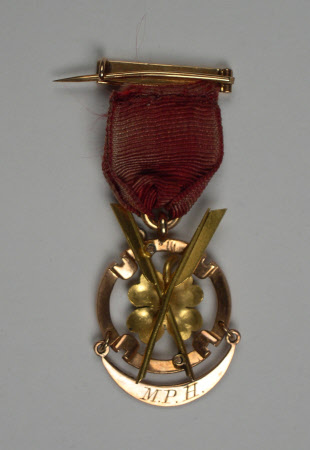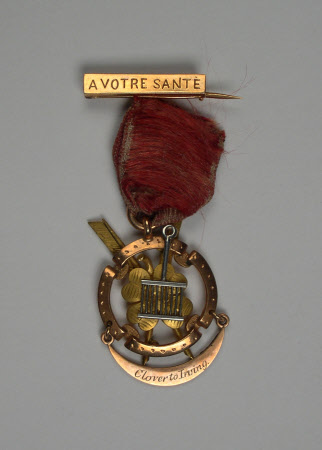A gold medallion for The Beefsteak Club circa 1880-1890.
Category
Jewellery
Date
1880 - 1890
Materials
Silk, Gold
Measurements
46 x 25 mm
Order this imageCollection
Smallhythe Place, Kent
NT 1117817
Summary
Beefsteak Club membership medal given to Henry Irving. Consists of pendant gold medallion on a red silk ribbon, suspended from a bar inscribed 'A votre sante'. Medallion made up of a gold ribbon circle containing a four leaf clover, a silver grid iron and two crossed arrows, fletched on one side only behind. The whole suspended below a crescent inscribed "Clover to Irving".
Full description
A gold medallion for The Beefsteak Club circa 1880-1890 designed as a gold circlet with four leaf clover centre and crossed arrows behind with platinum gridiron surmount suspending below a hinged crescent moon shaped drop engraved on the front 'Clover to Irving' and on the reverse the monogram 'M.P.H.' on a red silk ribbon with told bar brooch top fastener engraved 'A VOTRE SANTE.' The 'Sublime Society of Beef Steaks' (more commonly known as The Beefsteak Club) is today the oldest surviving dining society in Britain. Founded in 1735 on the principle that actors and 'other men of genius' could meet together and enjoy one another's company in a convivial setting. Its earliest Members included such prominent personalities of the day as William Hogarth and the actor John Kemble. A decline in its fortunes led to its temporary closure in 1897 although it was revived in 1876 following Sir Henry Irving's generous offer of allowing the dining room at The Lyceum Theatre to be used for the Society's meetings. It was Sir Henry who introduced a change to the 'men only' rule allowing the admission of woman as guests including ,in 1881, his great friend Ellen Terry. The 'gridiron' motif on the gold badge is a symbol for 'beef and liberty'- the declared values of The Beefsteak Club. Report by John Benjamin Honorary Jewellery Advisor August 2021.
Provenance
Believed to have been owned by or given to Ellen Terry (1847-1928) or her daughter Edith Craig (1869-1947) and came to the National Trust in 1939 when Edith Craig transferred Smallhythe Place (including buildings, land and contents) to the Trust
Credit line
National Trust (Smallhythe Pace)
Marks and inscriptions
M.P.H. (engraved on crescent, reverse)

